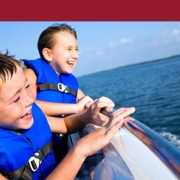A refresher on water sport and boating safety
Water sport and boating safety
As we enter the start of summer, people will spend more time on the water skiing, boating and riding personal watercraft.
But with more people on the water comes more potential for injuries. According to the U.S. Coast Guard, nearly 80 percent of all recreational boating injuries occur from May to September.
The personal and economic costs of boating injuries are high ̶ in 2013, the Coast Guard counted more than 4,000 accidents involving 560 deaths, 2,620 injuries and nearly $40 million in property damage.
According to the Boats U.S. trade association, 36 percent of boating fatalities involved an accident where someone went overboard, and 18 percent resulted from a collision ̶ usually with a pier or another boat.
What are the five primary contributing factors in recreational boating accidents? Operator inattention, improper lookout, operator inexperience, excessive speed and defective machinery.
Here are some boating safety tips to prevent you from being injured while on the water this summer:
- Wear a life jacket – In 2013, the Coast Guard reported 77 percent of boating deaths were caused by drowning, and a shocking 84 percent of those victims were not wearing life jackets. Be sure to wear Coast Guard-approved life jackets. Blow-up mattresses, water wings, foam “noodles” or inner tubes are not a substitute for life jackets.
- Avoid alcohol – Whether boating, waterskiing or riding personal watercraft, alcohol greatly increases the risks of an accident, regardless of whether the operator or passengers are drinking. Alcohol influences balance, coordination and judgment, and its effects are magnified by the summer sun and heat.According to the Coast Guard, where the primary accident cause is known, alcohol use is the leading known contributing factor in nearly 16 percent of all fatal boating accidents. The U.S. Centers for Disease Control and Prevention estimates alcohol use may be involved in nearly 70 percent of deaths associated with water recreation.
- Use the buddy system if swimming – Make sure someone knows where you are at all times and know the water terrain. Scan swimming areas for drop-offs, and be aware of hidden obstacles in the water.
- Watch for rip tides – Rip tides can occur along any coastline. Signs of a rip tide include discolored or foamy water that moves in a narrow channel away from the shore. If you find yourself caught in a rip tide, remember to swim parallel to shore until you’re outside the current, when you can swim back in
- Be Aware of Dehydration – Perhaps the most unrecognized danger to water skiers and personal watercraft riders is dehydration. This is especially common when riding on salt water. Water skiing and riding personal watercraft can be a vigorous physical activity, and it is possible to lose a great deal of water without realizing it. When a person becomes dehydrated, reaction time and awareness are impaired.
- Don’t Let Cool Summer Winds Fool You – While Frank Sinatra sang glowingly about the “Summer Wind,” there is a hidden danger. Cooling winds on the water can convince water skiers, personal watercraft riders or boaters that they are not receiving much direct sunlight. This is false, and many people sustain skin damage from sunburns.
Follow precautions so you can avoid the emergency room and spend more time outside enjoying the water this summer.
Sources
U.S. Centers for Disease Control and Prevention “Water-Related Injuries” (2014)
U.S. Department of Homeland Security, Office of the United States Coast Guard 2013
– See more at: http://blog.cinfin.com/2015/05/14/water-sport-boating-safety/#sthash.qRXGv7Z9.dpuf



